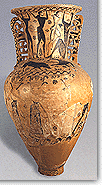The Attic pottery of the 7th century B.C. was called protoattic, which, from many point of views, constituted the antipode of protocorinthian pottery. It had a special preference for large shapes of vases, on which monumental forms could be freely developed and used for experiments of every kind, whereas at the same time the concept of separating the sides of the vase into main and secondary developed. On the main side the important representation was placed, whereas the secondary one was occasionally decorated by simple floral motifs. Silhouette and the technical outline for the figures were broadly used in the beginning of the century, but were gradually abandoned. The use of incision for the attribution of details began relatively late and remained an occasional phenomenon. Added colours -mostly white and less commonly red- were often used, around the middle of the century, whereas they were limited once again towards its end.
The representations drew their themes from mythology. The forms, even when they are orientalizing monsters have the angular structure of their Geometric predecessors. The narrative character of the scenes, and the rejection of every regulatory convention in the shape of the forms allowed the creation of some of the most lively compositions of that period.
Protoattic pottery is divided into the following periods:
|
Early protoattic, 700 - 675 B.C.
The production of vases continued. These vases were plastically decorated and their themes were inspired by some Geometrical standards. However, mythological scenes are not yet depicted. The most important representatives of that period were the Analatos Painter and the Mesogeia Painter.
|  |
 |
Middle protoattic, 675 - 650 B.C.
This is a period during which the Attic pottery was removed from the big markets and their developments, enabling it to proceed with research and innovations. There was a preference for large-shaped vases, on which narrative mythological scenes could be developed. The most important representatives of these tendncies were the Polyphemus Painter and the Ram Jug Painter. |
|
Late protoattic, 650 - 630 B.C.
During these years the imitation of the Corinthian black-figure technique began, applied with simultaneous use of white and red thus creating tricolour. Furthermore the preference for monumental forms and mythological subjects was maintained.
Protoblack-figure in Attica, 630 - 600 B.C.
This last phase corresponds to the full prevalence of the black-figure style and is distinguished for the strong Corinthian influences in iconography. The most important potter of that period was the Nessos Painter, who managed to combine technical perfection and the accuracy of the protocorinthian ceramics with the power and the drama of the protoattic one. He painted large craters and amphoras. |
 |


















